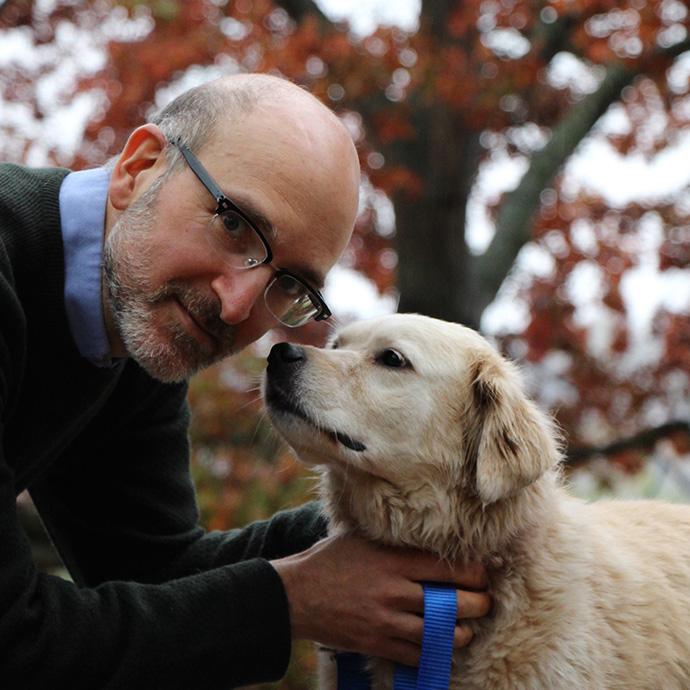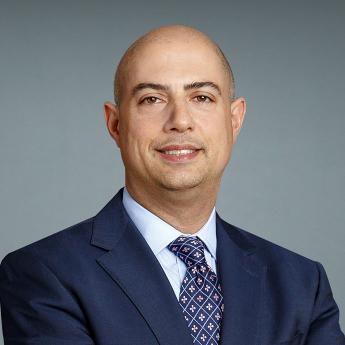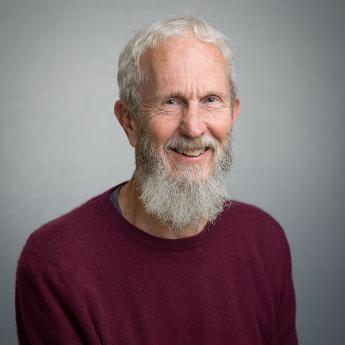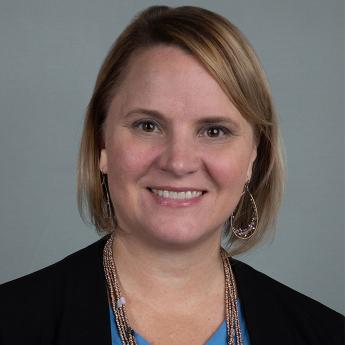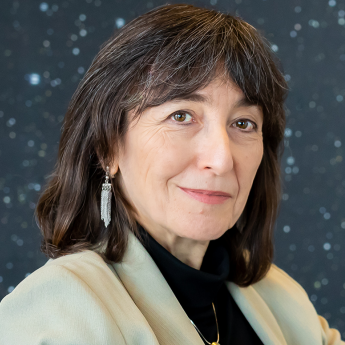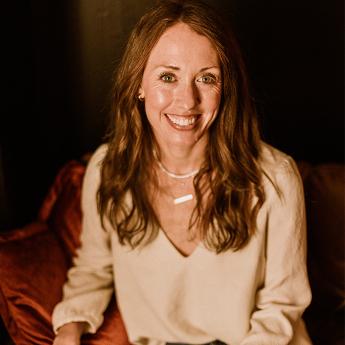Show Notes
Every dog owner has faced the hard realization that their dog won’t live as long as they do, but we’ve all probably wondered: Why do some dogs live longer than others? It turns out that several factors are at play, according to the largest research study of dogs, known as The Dog Aging Project.
Prof. Daniel Promislow of the University of Washington is co-director of the project, which was originally funded by the National Institutes of Health (NIH). It examines how biology, lifestyle and environment can increase both the health and lifespan of more than 50,000 dogs. We spoke with Promislow about whether we can help our dogs live longer—and what their research could actually teach humans about aging.
Link to the advertised Chicago Booth Review Podcast
Subscribe to Big Brains on Apple Podcasts and Spotify.
(Episode published April 4, 2024)
Subscribe to the Big Brains newsletter.
Please rate and review the Big Brains podcast.
Related
- Learn more about The Dog Aging Project
- Enroll your dog at the project website
- Could studying how dogs age help us understand the ways humans do?—KUOW
- Startup is developing a pill intended to help large dogs live longer—AXIOS San Francisco
- Aging Dogs Provide Insights for Human Longevity—The Scientist
Transcript:
Paul Rand: The University of Chicago Leadership and Society Initiative guides accomplished executive leaders in transitioning from their long-standing careers into purposeful on-court chapters of leadership for society. The initiative is currently accepting candidates for its second cohort of fellows.
Your next chapter matters for you and for society. Learn more about this unique fellowship experience at leadforsociety.uchicago.edu. Like most remotely recorded podcasts, there’s always a hidden guest hanging out in the background, and if they ever make a peep, they always get edited out. That’s my dog, my German Shepherd, Tilly. Come on. Good girl. Good girl. But it’s not just my dog. There’s also our producer’s dog, Morgan.
Tape: I am so sorry. I’ll go on mute.
Paul Rand: And pretty often our guest has a dog too.
Daniel Promislow: So that’s ... Can we pause?
Paul Rand: We can.
Daniel Promislow: We’re okay to edit this together?
Paul Rand: Yeah, of course, of course. Okay. That’s Daniel Promislow. He’s a professor at the University of Washington and a biogerontologist, someone who studies how and why we age.
Daniel Promislow: After I graduated from the University of Chicago in 1986, I went to Oxford University for my graduate work to do a DFL in evolutionary biology. Kind of by accident, I stumbled onto the question of the evolution of aging. Why is it that almost all organisms age and why are there dramatic differences from a little mouse or a vole that might live for a few months to an elephant that can live for 65 years and a whale that could live for a couple of hundred years? And of course, the dog is an amazing focus of my work. Now
Paul Rand: Promislow is now the co-director of the Dog Aging Project. A massive study initially funded by the NIH that’s tracking tens of thousands of dogs to learn as much as possible about how dogs age.
Daniel Promislow: Large-scale studies in a way that we do on people where we track tens of thousands of people over time, hadn’t really been done in dogs, and we realize that there’s so much we could learn.
Paul Rand: How important is exercise? Do dogs who eat less live longer? Does being in a house with other dogs increase lifespan? The Dog Aging Project is investigating all of these questions and more.
Daniel Promislow: We have now more than 50,000 people who have signed up their dog to the Dog Aging project.
Paul Rand: But for all those cat owners or even pet-less households out there, don’t change the dial just yet. This episode isn’t just for pet owners because it turns out ...
Daniel Promislow: Dogs are a great model for studying aging, partly because we want to understand aging in dogs for dogs, but also because what they can teach us about people. Dogs age in very many ways, just like we do.
Paul Rand: With the exception of AI, aging and longevity have become one of the hottest areas of research in the last few years. Most scientists look at human biology, genetics, but Promislow thinks we may be surprised by how much we can learn about human aging by studying dog aging.
Daniel Promislow: Many of their physiological systems age just like ours. So the different parts of our bodies that break down and don’t function as well as we get older, whether it’s our heart or our brain or our gut, the same is true in dogs.
Paul Rand: Welcome to Big Brains, where we translate the biggest ideas and complex discoveries into digestible brain food. Big Brains, little bites from the University of Chicago Podcast Network. I’m your host, Paul Rand. On today’s episode, how dogs age and what it tells us about human aging.
All right, everybody loves dogs and my understanding is it’s the most popular pet in America, I’m not sure about globally. Tell me this whole concept of why we love dogs so much and also what drove you to decide this was an area you wanted to study.
Daniel Promislow: Two great questions. One of the things that I’ve often thought about when I think about why it is that people are so closely bonded to dogs, dogs evolved with people. Dogs are a pretty new species in the last 25000 years or so. The last 25, 20, 30000 years of our evolution has been alongside dogs evolving. And I think that’s got to be part of the reason why we have this extraordinary bond-
Paul Rand: Fascinating.
Daniel Promislow: ... that they’re so much a part of our lives, probably originally as helpers, as working dogs, whether it was hunting or protecting. And of course now as emotional partners in life.
Paul Rand: Everyone listening has a baseline at most understanding or at least understanding of aging. But let’s talk about what’s actually happening inside living organisms, humans, dogs, as aging progresses. What fundamentally is shifting and changing that’s important for us just to have a good understanding of?
Daniel Promislow: It’s a great question and there’s so many ways to answer that question. We know a lot about what we call the hallmarks of aging. So the mitochondria that are found in each one of our cells, that is the powerhouse of each cell, those begin to fail as we age. So our cells have this amazing machinery inside that recognize when proteins haven’t folded correctly and we have many, many thousands of different kinds of proteins.
That machinery helps refold the protein so it’s correctly folded, or if it can’t do that, break it up and recycle the amino acids. That machinery starts to fail as we age. Many of you will have heard of telomeres, the ends of our chromosomes. Every time a cell divides, a little bit of those telomeres are chopped off.
And after enough divisions we start getting close to the DNA that’s actually doing important stuff and that can cause problems leading to cell dysfunction. The microbiome that is so important to our health, and as we age, another thing that happens is what’s called dysbiosis, that the good kinds of bacteria shift to be less common, the bad kinds of bacteria can become more common. And in fact, the kind of dysbiosis that we get with age in people is similar to what we see in dogs.
Paul Rand: All right, so if we had to go and give an answer as to why are we aging, you just explained the how we age, why are we aging and is it kind of this whole concept of planned obsolescence or how do you think about that, why we have biologically been geared to age?
Daniel Promislow: There’s the evolutionary answer to this really great question of why we age. If there’s a mutation that we inherit from our parents that causes problems when we are 20 or 10, that mutation is going to be weeded out by natural selection. But most of our work involved in passing our genes onto the next generation historically was done by maybe our late 30s, early 40s.
And most of what happened after that just didn’t matter. And so natural selection built our bodies to be able to do the things we need to do to raise our kids, to develop ourselves, and then raise our kids and make sure that they make it to adulthood. And after that, we’re carrying that mutation around and it doesn’t have any effects until we’re 90. Most of the time natural selection’s not even going to see it. And so it’s not going to be able to weed out that mutation.
You can think about all these mutations as ticking time bombs with short fuses and long fuses. The short-fused ones go off. They cause a lot of problems. They reduce fitness from an evolutionary perspective and they get selected out. The ones with really long fuses, like 90-year fuses never go off. And if they do by the time they go off, it doesn’t impact our ability to pass our genes onto the next generation. So that’s kind of an evolutionary why over-
Paul Rand: That’s a great answer.
Daniel Promislow: ... [inaudible 00:08:38] time, we are carrying around all of these potential problems, but they’re way in the future.
Paul Rand: That’s a great answer of understanding aging, your interest in aging. I’m not sure I’m tracking yet where dogs come into the picture.
Daniel Promislow: So there’s a little story there. My graduate work was in comparative biology, which means I collected a huge amount of data from the published literature on mammals, everything from mice to tigers to elephants. And one of the obvious patterns that we’re all aware of is that large species tend to live much longer than small species.
So 2007, a paper comes out in the Journal of Science, that’s the premier science journal in the US. And on the cover is a picture of a Chihuahua and a Great Dane walking side by side. Elaine Ostrander, who is a dog geneticist now at the National Institutes of Health and her group published a paper on the genetic architecture of size in dogs.
If you look at the genetics of size in humans, there are hundreds and probably thousands of genes, each of which contribute a tiny little amount. In dogs, if you look at the reason that your 90 pound German Shepherd dog and Great Danes and Bouviers are all really large and Toy Poodles and Chihuahuas are so small, mostly comes down to one gene, which they discovered, which is called insulin growth factor one, or IGF-I.
And so how did this lead me to study aging in dogs? Well, I was already working on aging and there were two pieces of knowledge that I already had that immediately made me want to study aging in dogs. One is the fact that unlike the pattern we see across species within dogs, it’s the large dogs that are short-lived, not long-lived, and that’s a curious thing.
And the other is that gene IGF-I, which many studies had already shown when you knock at IGF-I in a mouse, for example, it lives longer. So it seems to be associated with aging.
Paul Rand: Interesting.
Daniel Promislow: I and many others immediately thought maybe IGF-I or insulin growth factor one is the reason that large breed dogs don’t live for so long. But at the time I thought, oh, I want to work on this and I want to figure out if IGF-I is the reason that large breed dogs are short-lived.
So I’d never worked on dogs. At the time, I was at the University of Georgia in the genetics department and I reached out to a friend in the veterinary school there across the street. And after being introduced from one person to the next, finally I met Kate Creevey and she said, “Well, I don’t know about aging, but I’m happy to meet with you.” That was in 2007 and here we are now 17 years later, and she’s the chief veterinary officer of the Dog Aging Project.
And that was the genesis of the project. So we collect all of the survey data and then a large number of dogs limited only by the amount of funding we have from NIH. So about 7000 dogs have whole genome sequences so we can identify genes associated with everything you can imagine measuring. And within that group, a thousand of them are sent a kit every year to take to the veterinarian.
And we collect blood products, a fecal sample, a urine sample, hair, and we can do all kinds of molecular biology. And our hope is that we can actually discover biomarkers of aging that will improve our ability to diagnose and treat and eventually prevent aging-related diseases. So we actually are still recruiting dogs.
We just recruited our 50th thousandth dog to the study. Dog owners go to our website dogagingproject.org, where they can sign up their dog. We ask them to fill out a pretty lengthy survey. It’s about, it’s 10 parts, it takes an hour or two, but it tells us everything about the dog, its health, its lifestyle, its neighborhood, its biology, and so on. And we use that data to observe what happens as dogs age.
Paul Rand: In my understanding of reading some of your work is that in many ways humans are pretty similar to dogs or vice versa when it comes to aging. Tell us why that is and how that is.
Daniel Promislow: If you look at their risk of mortality as they age, the pattern is the same as in people. In humans, starting from about the age of 20, 25, our risk of mortality doubles every eight years. When we’re in our 20s and 30s, that risk is doubling, but it’s so small we don’t notice it. But it’s doubling.
And as we get older and older, it shows that exponential increase. The same pattern is true in dogs. And many of their physiological systems age just like ours. So the different parts of our bodies that break down and don’t function as well as we get older, whether it’s our heart or our brain or our gut, the same is true in dogs.
Paul Rand: One interesting example goes back to what first interested Promislow in dogs, size.
Daniel Promislow: So actually, yes, the data are a little mixed, but in general, shorter people tend to live longer. It’s a small effect, but it is in the same direction.
Paul Rand: So anybody that’s listening that doesn’t think they should date somebody shorter than them may have a different reason to think about it now.
Daniel Promislow: I don’t know. I think it’s all chemistry, it’s pheromones. If they smell good to you, go for it.
Paul Rand: But it’s not just the way that dogs age that makes them a great way to also study human aging. It’s also their environment.
Daniel Promislow: They live in our own environment and in some ways they are more in our environment than we are. So we walk on the grass, they’re rolling in the grass and chewing it. Any of the environmental risk factors that we are exposed to, dogs are as well.
But because everything is sped up in dogs by seven to tenfold, our ability to capture those effects, to identify those environmental risk factors that influence aging in dogs and other diseases are really an opportunity. So dogs are like a sentinel. It’s kind of like the canary in the coal mine for aging and age-related diseases, allowing us to identify the environmental factors, also the genetics, the lifestyle factors, biological factors that shape aging.
Paul Rand: Now there’s something also talked about in terms of variability, and I wonder if you can expand on that concept a little bit for us.
Daniel Promislow: Sure. Anyone who goes to a dog park and looks around will appreciate that dogs are one of the most variable species of animals in the world. If you were to be in the wild and you came across a Chihuahua and a Great Dane, you would not think they were the same species.
Paul Rand: Gotcha.
Daniel Promislow: So that tremendous variability turns out not only to be seen in what they look like and how they behave, but also in how they age. So we already talked about how large breed dogs are much shorter-lived, but each breed also has its own constellation of health challenges as it ages.
And so this gives us a tremendous amount of power to identify the risk factors for these aging-related diseases and also eventually to figure out how to better predict and diagnose and maybe even prevent these diseases. The genetic variation that I’ve talked about and the environmental variation gives us this power to discover genetic and environmental factors that influence aging and dogs.
And then to go looking to see if that’s also true in humans in a way that would be very hard initially to make those discoveries in people. Partly because we are so incredibly genetically variable. You can’t go to a human population and know with 50% certainty that this population is going to get dilated cardiomyopathy.
Whereas in Dobermans you can say something like that. And so there’s this power of discovery in the dog that for those who are interested in translating those discoveries to people will I hope lead to future research in people.
Paul Rand: The Dog Aging Project has already published many papers with their findings. What are the benefits of exercise, socialization? Does household income change how dogs age? Well, we’ll get into that right after the break.
If you’re enjoying the discussions that we’re having on this program, there’s another University of Chicago Podcast network show that you should check out. It’s called The Pie. Economists are always talking about the pie, how it grows and shrinks, how it’s sliced, and who gets the biggest share.
Join veteran NPR host Tess Vigeland as she talks with lean economists about their cutting edge research and key events of the day. Hear how the economic pie is at the heart of issues like the aftermath of a global pandemic, jobs, energy, policy, and much more. How can we improve communications at work? Why did McKinsey’s former CEO go to prison? How irrational are we really?
According to Chicago Booth’s, Richard Thaler and Harvard’s, Steven Pinker and our stock market’s actually efficient. The Chicago Booth Review podcast addresses the big questions in business policy and markets with insights from the world’s leading academic researchers.
We bring you groundbreaking research in a clear and straightforward way. Find the Chicago Booth Review podcast wherever you get your podcasts. On our last episode, we talked about Alzheimer’s disease. Well, it turns out humans aren’t the only ones who suffer from this kind of disease. Our furry friends do so as well, but for them it’s called canine cognitive dysfunction.
Daniel Promislow: So just like in people, as dogs get older, they are at risk of losing their cognitive function. And in many ways it looks like the kinds of patterns that we see in humans, both in terms of demography, in the population biology, it tends to occur very late. Same turns out to be true in dogs.
We don’t see canine cognitive dysfunction appearing generally until a dog is 11 or 12. For dog owners out there, you’ll notice a variety of things. Dogs might not recognize the people who they’ve been around their whole lives. They might get lost in the house. They might be under a chair or in a corner and not know how to get out of that situation.
Paul Rand: Is there anything that can be done to slow down this decline? Well, it turns out that early data points may hold some clues.
Daniel Promislow: We collect owner reports about exercise. We have a survey that measures cognitive function. One of the studies that was done showed that dogs that exercise more are less likely to have canine cognitive dysfunction or to score high, high is bad on the CCD.
Paul Rand: Our last guest on Alzheimer’s also said things like exercise and diet may be crucial factors in staving off the disease. But just as he also warned about confusing correlation and causation, Promislow thinks we still need to investigate further.
Daniel Promislow: It’s important to keep in mind that most of the work we’ve published so far was just from the first year. We’re now in the fourth year of data collection for those dogs at least that came on right at the beginning. When you look at just a cross section in one year, it’s hard to know what’s causing what.
So it might be that the dogs that exercise more have less cognitive dysfunction because actually they’re just healthier dogs. Healthier dogs exercise more and aren’t likely to have cognitive dysfunction or other diseases. We don’t yet know what’s causing what.
But the really exciting thing is because we have these measures of exercise from early on, and we’re following these dogs year after year after year, pretty soon we’re going to be able to look back and say of those dogs that have CCD three, four years ago when they didn’t, were they exercising more or less than the dogs that don’t have CCD?
Paul Rand: There’s another aging factor that we’ve talked about a lot on this show, loneliness. And it turns out some earlier data from Promislow’s team also shows that socialization may be an important factor in living longer for dogs as well.
Daniel Promislow: One of the really fascinating and surprising discoveries, our data suggests that dogs that live with other dogs tend to be healthier.
Paul Rand: Earlier we were talking about the parallels of lives and that the dogs are living in the environment in some ways even more close to it than we are. One of those things is thinking about health and human health and dog health in relation to income and financial status. And I imagine there’s nowhere more important than that than what each human and, or dog is eating.
Daniel Promislow: Yeah, diet is so important. When we think about human healthy aging, there are a few things that we know pretty well to maximize healthy lifespan in humans, exercise social interactions, healthy sleep habits, and diet. Diet’s probably number one.
We actually don’t know a lot about dogs because until our work, people haven’t been able to do studies on the scale that we do. So we ask people all about the food that they provide to their dogs, and we don’t ask people to change what they’re doing. We don’t want to interfere.
We just want to observe what people are doing and how that impacts aging. We published a paper a couple of years ago showing this intriguing relationship between how frequently a dog eats once a day, twice a day, three times a day, throughout the day, and how that feeding frequency relates to health. There were some strong patterns.
For example, dogs that feed once a day are dogs that are less likely to be diagnosed with pancreas problems or gut problems. But it’s really important thinking about these cross-sectional studies, just a slice in time to ask ourselves which way the causal arrows go.
It’s also possible that the reason we see that relationship is because dogs that are diagnosed with pancreatitis or with gastrointestinal problems are likely to be told by their veterinarian to give their dog many small meals a day instead of one big dog, sorry, one big meal.
Again, because we have this longitudinal data, over time we’ll be able to ask whether healthy young dogs feeding once a day versus multiple times a day have different aging trajectories. So that’s kind of the superpower of the Dog Aging Project.
Paul Rand: One of the things you did pull out though is that richer dog owners actually report more incidents of disease. What’s the correlation there?
Daniel Promislow: We observe a relationship between, for example, the exercise habits of a dog and the neighborhood that it lives in.
Paul Rand: Interesting.
Daniel Promislow: Neighborhoods that have more green space. For example, are neighborhoods where dogs are more likely to exercise. And so this is really, I think, a great opportunity for us to understand the relationship between the general environment, not just my house, but the broader environment that I live in.
Paul Rand: One possible link between income and health for dogs is that people in lower socioeconomic neighborhoods may be unable to walk their dogs as much due to safety concerns or a lack of time due to work, which means of course, less exercise.
Daniel Promislow: One possibility is that wealthier dog owners are more likely to be able to afford to take their dog to the veterinarian, and so they’re more aware of the diseases that that dog has. And actually, this is a real challenge in cohort studies.
In human cohort studies, we face the same challenge that often the people who sign up are people who have access to the information about the studies, easy access to the internet and so on. Our participants tend to be wealthier on average, we have a whole range, but on average they’re wealthier than the average American dog owner.
They’re a little more well-educated than the average American dog owner. So we really want everybody to sign up. That’s really important because we don’t want to just learn about the health trajectories of dogs of wealthy owners, for example.
Paul Rand: Well, as we’ve talked about at the beginning of our discussion, everywhere you turn, there are stories on improving human longevity. There’s more products coming out, there’s more focus coming out.
There’s people that are super hacking in every which way they can, their lifespan. And there looks like there’s some new treatments coming out to add some time to a dog’s life. And one of them is a drug called, let me see if I’m ... rapamycin, if that’s correct.
Daniel Promislow: So rapamycin is a drug that we’re actually studying in the Dog Aging Project. So the Dog Aging Project has enrolled about 50000 dogs. Eventually about 1% of those dogs, just over 500 will be enrolled in a clinical trial to study the effects of rapamycin on healthy aging.
Rapamycin is a molecule that was discovered on Easter Island or Rapa Nui, which is why it’s called rapamycin. It’s produced by bacteria. And it turns out that if you give low doses of rapamycin in the laboratory to mice, they live much healthier and much longer.
It’s actually used in humans that have undergone either solid organ or bone marrow transplant to help prevent rejection. So at high doses, it’s commonly used in transplant patients. It’s that these low doses that we see minimal side effects and dramatic increases in lifespan. We’ve enrolled but 150 dogs. So we are still enrolling.
We’re limiting that to large breed middle-aged dogs. The reason we’re not enrolling two-year-old Chihuahuas is that we would have to wait 15 years for an answer. So we’re looking at healthy, large breed, middle-aged dogs. These dogs are seen by specialty veterinarians and we have a safety board. So safety is our first priority.
It’s the first study of its kind where we’re testing a drug discovered in the lab for its ability to increase lifespan as well as health span in the real world. I should add that there are now some other studies of other drugs, one in particular being carried out by a company called Loyal. So there’s a lot of interest as you note among many people, and the possibility that we might increase healthy lifespan in people by drug interventions.
Paul Rand: Rapamycin isn’t the only drug that’s getting people excited about extending lifespan, but Promislow warns that we need to be careful about jumping to conclusions.
Daniel Promislow: We feel very strongly the Dog Aging Project team, which is about 100 people, it’s not just me, we feel very strongly that anything we say should be based on scientific discovery, that we won’t make claims unless the data backed them up. And my concern is that people out there are choosing to take drugs that they think might increase their own health span based on some studies that were done in nematode worms or in Drosophila fruit fly or in a mouse, which aren’t humans.
And without proper clinical trials, we don’t know about side effects, we don’t know about efficacy or effectiveness. And also I would say one of the challenges with the lab studies and all studies is we also don’t know to what extent an intervention like rapamycin that has been shown again and again to work in a particular strain of mouse, the C57 black six mouse, one of hundreds of strains of mice that are studied. Well, what if it doesn’t work in other strains?
And then we start treating people in the hope that we’re going to increase healthy lifespan. And maybe it would be beneficial in some people, but maybe deleterious in others. But also I think it’s the bigger challenge is appreciating that aging is so complex and it’s caused by so many thousands of biological and environmental factors that I really don’t believe that one size will ever fit all.
And so as we are hearing about, oh, rapamycin or metformin or acarbose, some of these may in fact increase healthy lifespan, but we also need to be thinking about what we call precision medicine for aging, which is precision geroscience that finding the best lifestyle choices and diet choices and so on for each individual given their own biology. And that’s a 10 or 20 year challenge I think we are facing.
Paul Rand: But there are some simple things we could all do today to improve our health span and Promislow says we can all look to the dog for inspiration.
Daniel Promislow: We know from aging research, as I mentioned, that there’s some basic things that you can do, get more steps in if you’re not walking very much. The latest data suggests maybe even 6000, 7000 steps a day is associated with longer lifespan. Try and have a healthy diet, try and get some good sleep, minimum of seven hours a day.
And most dogs we know are pretty good sleepers, if not great sleepers. So we can look to our dog for inspiration there. And most dogs love to run around outside. Again, they can inspire us. So there’s some pretty basic things that we can do to ensure that the healthiest lifespan. And again, we talk about health span, not lifespan.
The goal is not to try and have people living forever with multiple morbidities, but being as healthy as they can possibly be. And I think that’s our goal-
Paul Rand: For as long as they can.
Daniel Promislow: ... for both dogs and people. And we still have a ton to learn. We’re just beginning. Aging is incredibly complex and yet it’s worth studying because it’s the number one risk factor for just about every major cause of mortality, whether you’re talking about cancer, heart disease, cognitive dysfunction. So if we can understand the underlying mechanisms of aging and help people be healthier agers, we think that’s going to have a beneficial impact on all these different diseases.
Matt Hodapp: Big Brains is a production of the University of Chicago Podcast Network. We are sponsored by the Graham School. Are you a lifelong learner with an insatiable curiosity? Access more than 50 open enrollment courses every quarter. Learn more at graham.uchicago.edu/bigbrains. If you like what you heard on our podcast, please leave us a rating and review. The show is hosted by Paul M. Rand, and produced by Lea Ceasrine and me, Matt Hodapp. Thanks for listening.
Episode List
How bioelectronics could heal our bodies and minds, with Bozhi Tian (Ep. 151)
Scientists design living devices to fight infections, power the heart and regulate the brain
Could a fungal pandemic be “The Last of Us?” with Arturo Casadevall (Ep. 150)
Scientists warn against a potential health threat due to climate change, resistance to drugs
What’s the truth about alcohol’s benefits and risks? with Tim Stockwell (Ep. 149)
Research on red wine and moderate drinking were skewed, scholar claims
What happens when we die? with Sam Parnia (Ep. 148)
Research on consciousness sheds new light on the line between life and death
Can we predict the unpredictable? with J. Doyne Farmer (Ep. 147)
Using complexity economics and chaos theory, scholar leverages big data to forecast everything from the stock market to roulette
Unlocking the Secrets of ‘SuperAgers,’ with Emily Rogalski (Ep. 146)
Neurologist explains why some 80-year-olds with exceptional memories are defying aging
Nobel laureate explains what makes countries fail or succeed, with James A. Robinson (Ep. 145)
Economist examines global inequality and what drives prosperity and poverty
Why can’t scientists agree on the age of the universe? with Wendy Freedman (Ep. 144)
A renowned cosmologist explains conflicting research around the Hubble constant and the Standard Model of physics
What are we getting wrong about young voters?, with Cathy Cohen (Ep. 143)
GenForward survey examines Gen Z’s and millennials’ views on the issues, candidates in the 2024 election
Why are more women saying no to having kids?, with Peggy O'Donnell Heffington (Ep. 142)
Book examines the complicated history of motherhood and choosing to be childfree
